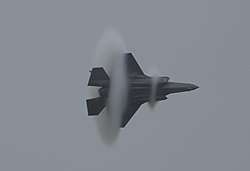Vapor cone
A vapor cone, also known as shock collar or shock egg, is a visible cloud of condensed water that can sometimes form around an object moving at high speed through moist air, for example, an aircraft flying at transonic speeds. When the localized air pressure around the object drops, so does the air temperature. If the temperature drops below the saturation temperature, a cloud forms.
In the case of aircraft, the cloud is caused by expansion fans decreasing the air pressure, density and temperature below the dew point. Then pressure, density and temperature suddenly increase across the stern shock wave associated with a return to subsonic flow behind the aircraft. Since the local Mach number is not uniform over the aircraft, parts of the aircraft may be supersonic while others remain subsonic—a flight regime called transonic flight.
In addition to making the shock waves themselves visible, water condensation can also occur in the trough between two crests of the shock waves produced by the passing of the object. However, this effect does not necessarily coincide with the acceleration of an aircraft through the speed of sound or Mach 1.[1]
Examples
These condensation clouds can often be seen appearing around space-bound rockets as they accelerate through the atmosphere. For example, they were frequently seen during Space Shuttle launches, about 25 to 33 seconds after launch, when the vehicle was traveling at transonic speeds. Similar effects were also visible in archival footage of some nuclear tests. Scientists observing the Operation Crossroads nuclear tests in 1946 named the transitory cloud a "Wilson cloud" for its superficial similarity to the Wilson cloud chamber effect.[2]
Gallery
.jpg) Ares I-X test rocket during launch October 28, 2009
Ares I-X test rocket during launch October 28, 2009.jpg) F/A-18A at transonic speed
F/A-18A at transonic speed Complex set of condensation cones surrounds a F/A-18C at transonic speed
Complex set of condensation cones surrounds a F/A-18C at transonic speed F-35 with a double vapor cone
F-35 with a double vapor cone
References
- Wilkinson, Jeff. "Wilk4: Breaking the Sound Barrier (and Vapor Cones around Jets)". Wilk4.com. Retrieved 2012-10-31.
- "Operation Crossroads: Fact Sheet". History.navy.mil. Retrieved 2012-10-31.
External links
| Wikimedia Commons has media related to Aerodynamic condensation from shockwaves. |